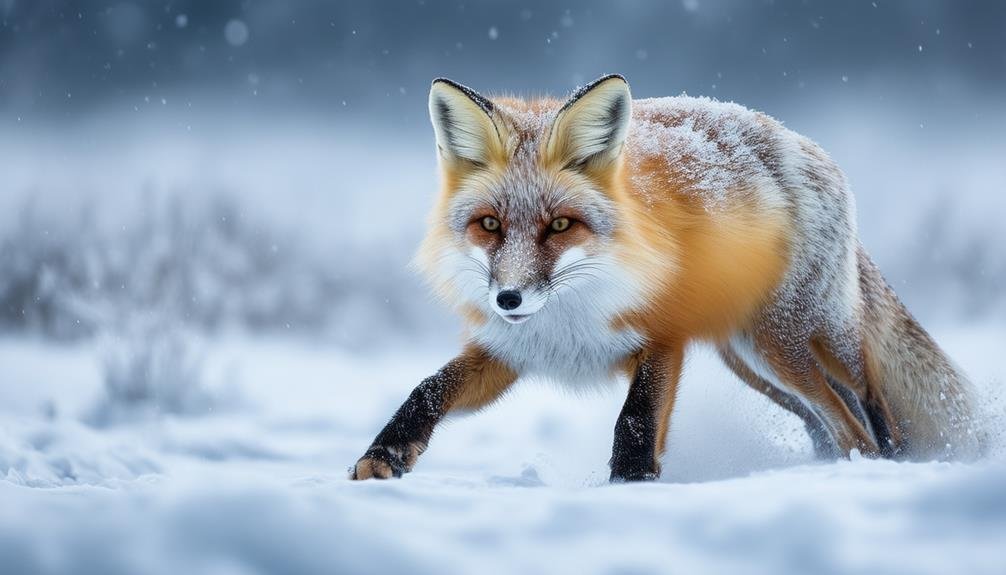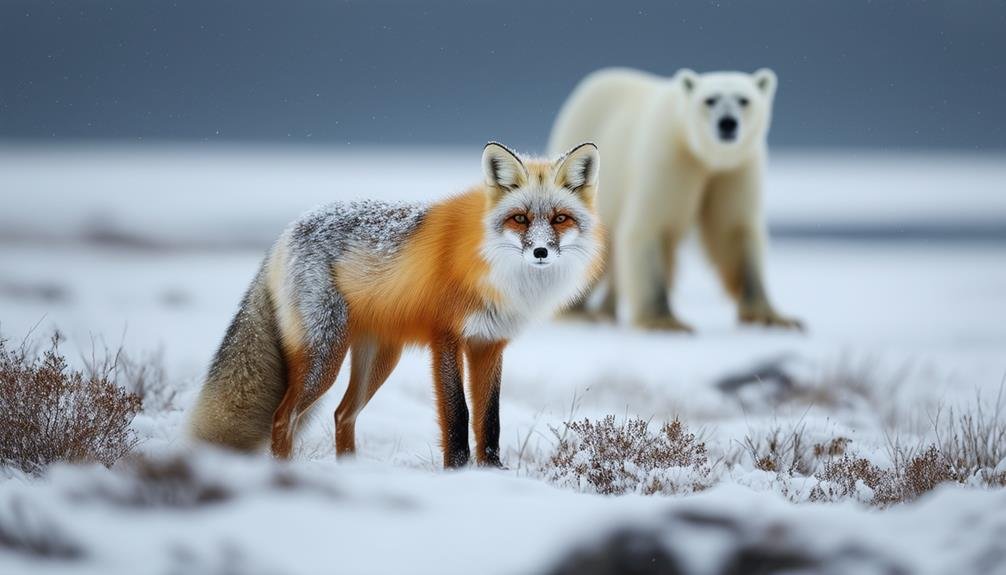Arctic foxes thrive in the tundra due to numerous specialized adaptations and behaviors. Their thick fur and substantial body fat provide essential insulation against extreme cold. Small ears and furry toes reduce heat loss and enhance traction. Seasonal fur changes offer camouflage and temperature regulation, optimizing their survival year-round. These foxes exhibit efficient hunting strategies, including a sharp sense of smell and agility, allowing them to effectively locate and capture prey. Their versatile diet consists of small mammals, birds, and scavenged food, supplemented by vegetation and insects. Understanding these unique traits reveals the remarkable resilience of arctic foxes in harsh environments.
Main Points
- Thick fur and body fat provide essential insulation and temperature regulation.
- Seasonal fur changes enhance camouflage and efficiency in varying temperatures.
- Sharp sense of smell and stealth aid in successful hunting and scavenging.
- Opportunistic and flexible diet allows survival on small mammals, birds, and scavenged food.
- Adaptations like small ears and furry toes reduce heat loss and improve traction.
Physical Adaptations
Arctic foxes possess several physical adaptations that enable them to survive the extreme conditions of the tundra. One of the most notable adaptations is their thick fur, which provides essential insulation against the harsh, cold climate of the tundra. This dense fur, along with a substantial layer of body fat, helps maintain the fox's internal temperature, essential for survival in an environment where temperatures can plummet drastically.
Their small ears are another crucial adaptation, minimizing heat loss by reducing the surface area exposed to the cold. Additionally, the Arctic fox's furry toes not only help in maintaining warmth but also provide better traction on the icy and snowy terrain, ensuring more efficient movement across the frozen landscape.
The Arctic fox's white coat serves a dual purpose: it offers excellent camouflage against the snow-covered ground, protecting them from predators and aiding in their stealth while hunting. Moreover, Arctic foxes have a low metabolic rate, which conserves energy during the long, frigid winters. These combined physical traits enable the Arctic fox to thrive in one of the most challenging climates on Earth, demonstrating remarkable resilience and adaptability in the unforgiving tundra.
Seasonal Fur Changes
Another remarkable adaptation of the Arctic fox is its ability to change fur color with the seasons, ensuring best survival in the variable conditions of the tundra. In winter, Arctic foxes don a thick, white coat that provides essential insulation against the extreme cold. This white fur not only helps in regulating their body temperature but also serves as an effective camouflage, blending seamlessly with the snowy landscape to evade predators and approach prey undetected.
As the season shifts to summer, Arctic foxes undergo a significant fur color transformation. They shed their winter coat in favor of a shorter, thinner fur that varies in shades of grey, brown, or bluish brown. This seasonal change allows them to better adapt to the warmer environmental conditions of the tundra biome.
The importance of this fur transformation can be summarized in three key points:
- Insulation: The thick winter fur provides necessary warmth to survive frigid temperatures.
- Camouflage: Seasonal color changes enhance their ability to blend with the environment, aiding in both predation and predator avoidance.
- Temperature Regulation: Adjusting fur density and color aids in maintaining ideal body temperature throughout the year.
These adaptive changes are crucial for the Arctic foxes' survival in their harsh, fluctuating habitat.
Efficient Hunting Strategies

Efficiency and adaptability define the hunting methods of Arctic foxes, enabling them to thrive in the challenging tundra environment. These foxes utilize their sharp sense of smell to pinpoint the location of prey such as lemmings and voles beneath the snow. By employing stealth and agility, they can effectively leap and nose-dive into the snow, securing their elusive prey with remarkable accuracy.
Arctic foxes exhibit persistent hunting techniques, allowing them to scavenge on carcasses left by larger predators. This opportunistic behavior guarantees their survival in the harsh conditions of the tundra, where food can often be limited. Their adaptability extends to diversifying their diet, incorporating a variety of food sources such as berries, insects, fish, and seabirds. This dietary flexibility is a testament to their ability to adjust hunting methods based on available resources.
Moreover, Arctic foxes demonstrate an ingenious adaptation by storing excess food in caches during times of abundance. These reserves become essential during periods of scarcity, providing a reliable food source when hunting conditions are unfavorable. Through these efficient hunting methods and versatile adaptations, Arctic foxes maintain their resilience and continue to flourish in the tundra's demanding ecosystem.
Diet and Nutrition
Understanding the diet and nutrition of Arctic foxes is essential to appreciating how they sustain themselves in the harsh tundra environment. The Arctic fox's diet is diverse and adaptable, allowing them to thrive despite the challenging conditions of the Arctic tundra. Primarily, they feed on small mammals, such as voles and lemmings, which are abundant during the warmer months. These small mammals form the cornerstone of their diet, providing the essential nutrients needed for survival and maintaining their thick fur, which is vital for insulation against the cold.
In addition to small mammals, Arctic foxes also consume a variety of other food sources to maintain a balanced diet. These include:
- Birds and their eggs: Arctic foxes hunt birds and raid nests for eggs, especially during the breeding season.
- Scavenged carcasses: They often scavenge on carcasses left by larger predators, maximizing their caloric intake.
- Berries, vegetation, and insects: These supplementary food sources provide additional nutrients, particularly when primary prey is scarce.
During the harsh winter months, Arctic foxes rely on cached food stores to survive, demonstrating their remarkable adaptability. However, climate change poses a threat to the Arctic fox's food supply, potentially impacting their survival rate in the long term.
How Do Arctic Fox Adaptations Contribute to Their Survival in the Tundra?
Arctic fox adaptations play a crucial role in their survival in the harsh tundra environment. Their thick fur provides insulation against freezing temperatures, while their compact bodies minimize heat loss. Additionally, their seasonal coat color changes from white in winter to brown in summer, enabling them to blend into their surroundings and avoid predators.
Predators and Threats

Arctic foxes face numerous predators and threats that challenge their survival in the harsh tundra biome. Among the primary predators are wolves, polar bears, and birds of prey, which pose constant risks to their safety. Additionally, the changing climate exacerbates these threats, as climate change notably alters their habitat and the availability of food sources, leading to increased competition for resources.
Human activities, particularly oil drilling, further threaten the survival of Arctic foxes by contributing to habitat loss. Such disruptions not only reduce the areas in which these animals can live and hunt but also introduce pollutants that can harm their health. Overhunting and trapping for fur have historically contributed to population declines, although regulations have been enacted to curb these practices.
Diseases and parasites present another layer of difficulty for Arctic foxes. In the tundra's extreme conditions, an outbreak can swiftly decimate local populations. These threats, combined with the challenges posed by natural predators and human-induced changes, create a precarious environment for Arctic foxes. Efforts to mitigate these impacts are crucial to ensuring the continued survival of this resilient species in their native tundra habitat.
Conclusion
Arctic foxes thrive in the tundra due to a combination of physical adaptations, such as thick fur and compact bodies, and seasonal fur changes that provide camouflage and insulation. Efficient hunting strategies, a varied diet, and the ability to store fat for lean periods further enhance their survival. Despite facing threats from predators and environmental changes, these adaptive traits enable Arctic foxes to maintain their niche in the challenging tundra ecosystem.


